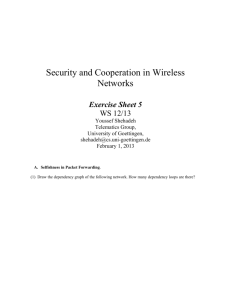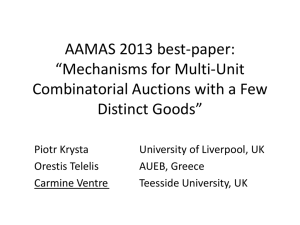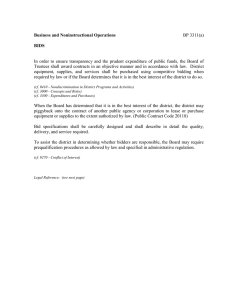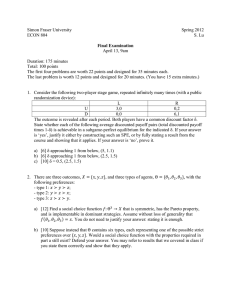Ascending Combinatorial Auctions = a restricted form of preference elicitation in CAs
advertisement
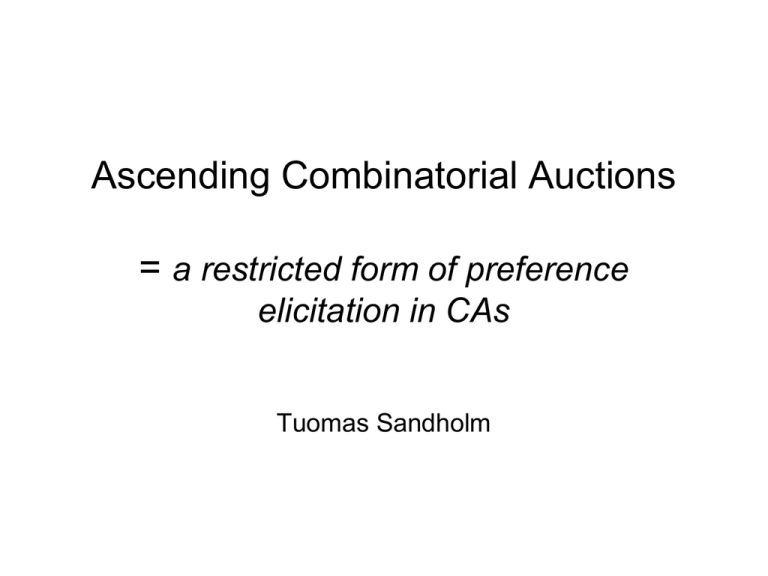
Ascending Combinatorial Auctions = a restricted form of preference elicitation in CAs Tuomas Sandholm Advantages of ascending CAs • Same motivation as other multiagent preference elicitation methods • Transparency • Dynamic exchange of information – With correlated values, can lead to increased revenue Price hierarchy • We consider several classes of pricing functions: 1. Linear: pj for each jG, p(S) = ΣjSpj 2. Non-linear: p(S) for each bundle S 3. Non-linear and non-anonymous: pi(S) for each bundle S and bidder i • 3 generalizes 2 generalizes 1 Competitive equilibrium • Let agent i’s surplus πi(Si,p) = vi(Si) – pi(Si) • Let ΠS(S,p) = Σi pi(Si) • Prices p and allocation S* are in competitive equilibrium (CE) if: 1. πi(Si*, p) = maxS [vi(S) – pi(S), 0] (for all i) 2. ΠS(S*, p) = maxS Σi pi(Si) s.t. S feasible • So, a CE (S*,p) is such that S* maximizes the payoff of every bidder and the seller, given the prices • Allocation S* is said to be supported by p in CE • Theorem: Allocation S* is supported in CE iff S* is efficient • CE prices always exist (e.g. pi = vi) Existence of CE prices • Some ascending CAs are designed to output a CE • We just saw that non-linear, non-anonymous prices always exist • But linear and non-linear anonymous prices do not always exist – Under what conditions do they exist? … When do linear CE prices exist? • Theorem If each agent’s valuation function satisfies “goods are substitutes”, then linear CE prices exist • Special cases – Unit-demand valuations – Additive valuations – Downward-sloping valuations When do non-linear anonymous prices exist? • Non-linear anonymous prices exist if 1. valuations are supermodular, i.e., increasing returns, or 2. bidders are single-minded, or 3. bidders have “safe” valuations (each pair of bundles with positive value share at least one item) Minimal CE prices • Def. Minimal CE prices are CE prices where the seller’s revenue is minimized • For certain valuations, minimal CE prices correspond to VCG payments – Thus, truthful bidding is ex post equilibrium • Since minimal CE prices are a restriction of CE prices, a minimal CE allocation is efficient • Minimal CE prices always provide upper bound on VCG payments Buyers are substitutes • Let w(L) for L I denote the value of the efficient allocation for CAP(L) • Def. A valuation v satisfies the buyers are substitutes (BAS) condition if: w(I) – w(I \ K) ≥ SiK [w(I) – w(I \ i)] for all K I • Thm. BAS holds iff VCG payments are supported in minimal CE Buyer-submodular • Recall: Buyers are substitutes (BAS) if: w(I) – w(I \ K) ≥ SiK [w(I) – w(I \ i)] for all K I • Slightly stronger version: Buyersubmodular (BSM): w(L) – w(L \ K) ≥ SiK [w(L) – w(L \ i)] for all K L, L I • Some ascending CAs require the BSM condition to terminate in a minimal CE Universal CE prices • BAS does not hold in many practical cases – Then, by the previous theorem, VCG not reachable in minimal CE • We can reach a stronger condition by further restricting the price equilibrium concept • Def. Prices p are universal competitive equilibrium (UCE) prices if p are CE prices and p-i are CE prices for CAP(I \ i) • UCE prices (non-linear, non-anonymous) always exist (e.g. pi = vi) • Minimal CE prices are universal iff BAS holds • VCG outcome and payments determinable from UCE prices – Thm. Let p be UCE with efficient allocation S*. The VCG payment to bidder i is: qi = pi(Si*) – [PI*(p) – PI\i*(p)] where PL*(p) = maxS ∑ pi(Si) for bidders L I, S feasible Communicational complexity lower bounds • Thm Any CA that implements an efficient allocation must compute CE prices • Thm Any CA that implements the VCG outcome must compute UCE prices Design dimensions of ascending CAs • Timing – Continuous: faster propagation of info, difficult winner determination – Discrete: runs according to planned schedule • Feedback – Prices, bids, provisional allocation – Tradeoff between effective bid guidance and mitigating collusion risk • Bidding rules – Bid improvement rule / percentage improvement rule – Activity rules (to help de-motivate sniping) – Revealed preference rules • Termination conditions – Fixed vs. rolling • Bidding language • Proxy agents • Price update rules: myopic vs. planned ahead [Nguyen & Sandholm EC-14] Price-based ascending CAs • Each auction in this family has roughly the same structure – In each round, announce prices and allocation – Receive bids – Update prices and allocation – Stop if termination criterion met Price-based ascending CAs Name Valuations Price structure Language Price update method Outcome KC Substitutes Non-anon items OR-items Greedy CE SAA Substitutes Items OR-items Greedy CE GS Substitutes Items XOR Minimal Min CE Aus Substitutes Items Single Greedy VCG iBundle & Ascending proxy BSM Non-anon bundles XOR Greedy VCG … General … … … Min CE dVSV BSM Non-anon bundles XOR Minimal VCG Clock-proxy BSM Items (+proxy) XOR Greedy VCG … General … … … Min CE RAD General Items OR LP-based - AkBA General Anon bundles XOR LP-based - iBEA General Non-anon bundles XOR Greedy VCG MP General Non-anon bundles XOR Minimal VCG Results assume straightforward bidding Price update methods • Greedy: Price is increased on some set of the over-demanded items/bundles • LP-based (Connection between auctions and optimization algorithms goes back at least to Danzig (1963). For an excellent modern presentation about this for CAs, see Mechanism Design: A Linear Programming Approach by Vohra, Cambridge Univ. Press, 2011.) – Subgradient algorithm (slower convergence, and convergence can require price adjustments to become infinitesimally small) – Primal-dual algorithm (faster converge) Subgradient-algorithm-based CA framework • Initialize prices (potentially on bundles and nonanynymous) to zero • Repeat – – – – Each agent i choose a surplus-maximizing bundle Bi If a bidder has zero surplus, he reports that he is inactive Seller chooses revenue-maximizing allocation a* If each active bidder k gets her most-preferred bundle Bk, stop – Otherwise, for each active bidder k, increase price pk(Bk) by Δ>0 Primal-dual auction design Primal-dual-algorithm-based CAs • Algorithm: – Formulate CA as an LP with integral optima. Dual should allow convergence to UCE prices (or minimal CE prices in the case of BAS) – Use bidding language that is expressive for straightforward bidding, and formulate a WDP to compute feasible primal solution that minimizes violation of complementary slackness conditions as represented by bids – Terminate when provisional allocation and ask prices satisfy complementary slackness conditions (and thus represent a CE), and also satisfy any additional conditions needed to compute VCG payments (e.g., UCE conditions or minimal CE conditions under BAS) – Otherwise, adjust prices to make progress toward an optimal dual solution that satisfies these conditions • The primal-dual approach also tells how much each price can be changed • Not all algorithms in this family are ascending – Can choose an ascending variant that works correctly --- by ensuring that a certain “overdemand property” is satisfied throughout the auction process. For this, it suffices to start from zero prices and use a “minimal” price update: • Prices are increased on the bids from a set of “minimally undersupplied bidders” in the provisional allocation Other CA designs used in practice • Clock-proxy auction [Ausubel, Cramton & Milgrom, Ch. 5 of CA book] – Run a parallel clock auctions for the items until no item is overdemanded. Then run a last-and-final proxy round • In proxy round, bidders report values to their respective proxy agents. The proxy agents iteratively submit package bids on behalf of the bidders, selecting the best profit opportunity for a bidder given the bidder’s inputted values. The auctioneer then selects the provisionally winning bids that maximize revenues. This process continues until the proxy agents have no new bids to submit. • XOR bids; all bids remain active; revealed preference consistency requirement • Combines the simple and transparent price discovery of the clock auction with the efficiency of the proxy auction • Linear pricing maintained as long as possible, but is abandoned in the proxy round to improve efficiency and enhance revenue • Other core-selecting CAs [e.g., Day & Milgrom] – Constraint generation is used to make this computationally feasible – (actually select a core for revealed valuations, assuming bidders act truthfully) • But bidders are not generally motivated to bid truthfully • If bidders use envy-reducing strategies, then these converge to an envy-free fixed point, and those points have revenue same or greater than VCG [Othman & Sandholm AAAI-10] – Can be supported by envy-quotes Open problems • Design ex post truthful ascending CA that does not suffer from problems of VCG (collusion, low-revenue) • See two technical preference elicitation problems in our JMLR-04 paper

